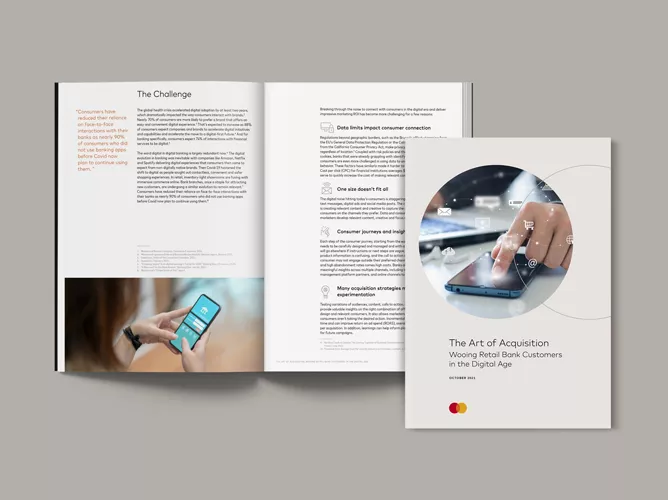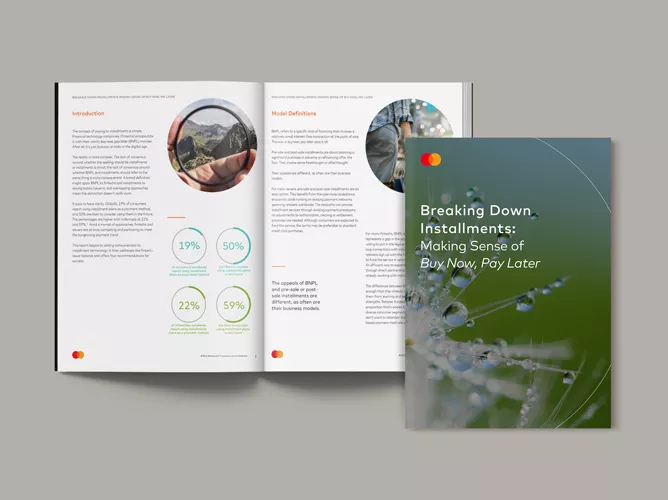Processing competition from fintech innovators
By: Patricia Reynolds, Vice President, Mastercard Advisors, Data & Services
The payments landscape is rapidly evolving and putting pressure on all parts of the ecosystem, particularly for traditional card processors.
They’re feeling pressure from digital players and nimble financial technology (fintech) companies, which can be better positioned to quickly navigate and respond to changes in how we pay for goods and services, including contactless, cashless payments and digital payments. Non-card and “no touch” payments have gained significant traction, spurred by the pandemic, with real-time payments also growing in popularity. The digital payments market is forecasted to grow at a compound annual growth rate of 13.7% between 2021 and 2026.1 Payments made via mobile devices alone are expected to exceed $2 trillion globally by 2023.
The digitization of all things payment, such as digital currencies, digital wallets and the digitization of the customer experience, is putting pressure on traditional processors to assess their own relevancy. Many are evaluating either mergers and acquisitions or partnerships with fintech companies better positioned to respond to market trends and requirements. Fintech companies can offer modern, cloud-based platforms and solutions that are more flexible and cost-effective compared to their legacy counterparts.2 These platforms offer “dynamic scaling,” which accommodates for payment volumes (or number of transactions). This feature is critically important in card processing for its scalability.
As early as 2013, card processing as a commodity was gaining traction and notoriety given that processing is a difficult business model that requires scale and volume. The scale and volume can come from clients that provide robust numbers of accounts and transactions or the consolidation of payment technology companies that provide the economies of scale due to larger books of business.
We saw a wave of consolidation in 2019 – Fiserv acquired First Data, WorldPay was sold to FIS and Global Payments merged with TSYS. What does all this mean within the broader landscape of card payments processing? Does it better position the processors to compete with fintech companies by offering more integrated payment solutions or does the reduction in competition result in higher costs for bank users of the services? Does this wave of consolidation solve for any of the problems associated with legacy, mainframe processing environments?
To answer these questions, let’s start by understanding the competitive differentiators of fintech companies in the card processing space and the “white space” they fill in traditional cards processing.
Fintech processors are companies built on modern technology stacks with cutting-edge solutions and capabilities. These entities, in some cases, have been around for decades, while others are new to the market. They’re cloud-based, real-time focused, and can be easily integrated with any system. This enables short integration periods – in some cases as little as 4-6 weeks for a new card launch – and the ability to quickly pull in emerging products, such as alternative underwriting, cryptocurrency support and instant issuance.
Despite fintech companies having more modern technology and a greater ability to capture emerging trends, fintech processors aren’t necessarily dominating the processing space. Breaking into the processing market requires volume and scale, and a long track record of reliability and fully developed solutions. Many issuers, between the long contract lifecycle, resistance to change and significant switching costs, haven’t traditionally turned to fintech innovators for their processing needs. The challenge for fintech companies in capturing the traditional payments business has pushed many of them into new areas not traditionally penetrated by many processing players.
For example, fintech companies are getting into payments/cards as a service, a white-label solution offered by processors for issuing cards without having to be a bank or meet compliance requirements. Fintech companies have also started supporting small and emerging issuers, providing debit and prepaid processing, and offering issuing capabilities to anyone who qualifies. Furthermore, fintech processors have also opened new non-traditional offerings, such as alternative underwriting, for consumer and commercial customers to gain a piece of the pie.
That changed in 2016 with the emergence of neobanks, which are fintech companies that offer digital-only financial services and no physical locations. The payments community support for neobank features and functionality hit mainstream in 2019 and the payments tech race accelerated.
Fintech innovators, in greater numbers than seen before, are now included in vendor assessments of issuers’ processor contract renewals. This is creating not only new business opportunities, but fairly sizable ones, for fintech processors and positioning them to compete in the more traditional areas of payments such as consumer and commercial credit. Will it be enough to unseat the traditional players? It’s too early to tell but they are forcing the traditional players to take a hard look at their capabilities and functional offerings.
Patricia Reynolds is Vice President of Product Management for Mastercard Advisors. To learn how Mastercard can help your financial institution navigate changes in the payments landscape, visit our Fintech page for additional resources.
2Finextra, “Why cloud payment processing is the answer to scaling challenges at banks,” July 27, 2021












